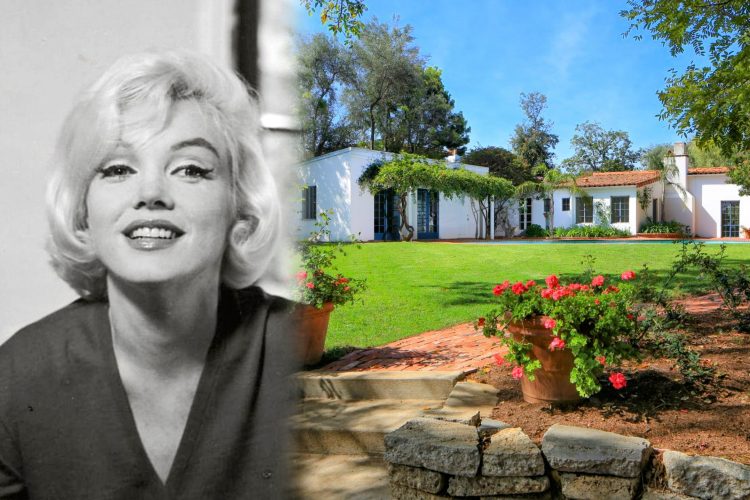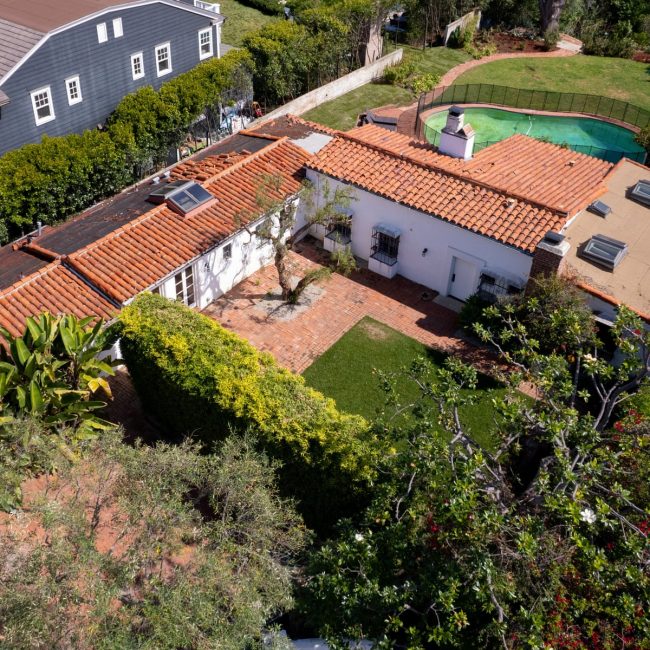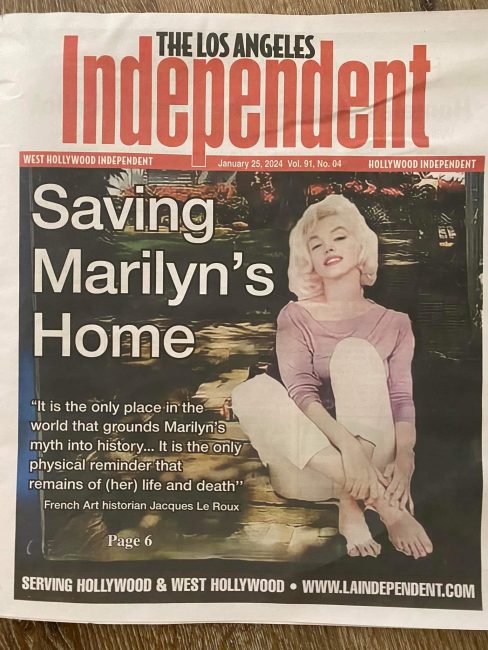
After plans to demolish Marilyn’s last home at Fifth Helena Drive in Brentwood, Los Angeles were recently made public (see here), Monroe fans joined forces with local preservationists to campaign for a reprieve – and the city’s Heritage Commission has now nominated the property for historic-cultural monument status, as Virginia Chamlee reports for People.
“The commission voted unanimously on Thursday, January 18, to designate Monroe’s home, located at 12305 W. 5th Helena Drive, a historic property, with commissioners noting that although Monroe only lived at the property for a few months, it was the only home the Hollywood icon ever purchased herself. It’s also the home where she tragically died at the age of 36 in 1962,
However, the house’s future isn’t entirely secured.
In Los Angeles, designation as a Historic-Cultural Monument ‘does not guarantee that the property cannot be demolished,’ according to the city, but it does allow the Commission to delay demolition for 180 days while other opportunities for preservation are determined. The next step in saving the property is a review of the nomination by the L.A. Planning and Use Committee and then the LA City Council.
The designation of the home as a historic site also does not preclude the idea that the home could at some point be relocated to a more central location — one more easily viewable by the public than the current neighbourhood in which it sits. Relocation would be a lengthy and costly process, however, and it remains unclear if the home would be able to be relocated.
The property was facing the possibility of destruction after the Department of Building and Safety issued a demolition permit to its current owner, Glory of the Snow Trust on Sept. 5. Days after it was issued, the L.A. City Council meeting unanimously voted to temporarily suspend said permit amid public outcry. L.A.’s Office of Historic Resources performed various assessments in the weeks following the issuance of the permit to recommend that Monroe’s Spanish-style abode be permanently protected and designated a historic site.
Scott Fortner, a historian, collector, and host of the All Things Marilyn podcast, has played a key role in saving the house as part of the Monroe Preservation Group, which he says has ‘worked tirelessly for months researching and documenting the history of Marilyn Monroe’s former and final home.’
The group has found historical significance in the house well before the blonde bombshell’s tenure. ‘Our efforts and research, which was shared with today’s deciding body, concluded that famed historic Los Angeles architect Harbin Hunter not only lived at the home, but he also very likely designed it.’ The evidence lies in the famous tiles at the front door of the house, which read, ‘Cursum Perficio,’ the Hunter family motto … Adds Fortner, ‘Our group, which consists of authors April VeVea, Gary Vitacco-Robles and Elisa Jordan, film producer and director Remi Gangarossa, and historians Kelly Lacroix and I, are thrilled to have participated in the process to have Marilyn’s home be recommended for a Historic Cultural Monument designation by the Los Angeles Cultural Heritage Commission today.’
Monroe purchased the 2,624 sq. ft. hacienda for $77,500 in February 1962. The stucco home was built in 1929 and features four bedrooms, three baths, beamed ceilings, a grassy courtyard, gardens, a swimming pool, and more. A presentation delivered ahead of the vote explained how, in her short time living there, Monroe spent roughly $51,000 refurbishing and renovating the home. When adjusted for inflation, that comes out to more than $500,000.”

And from NBC Los Angeles, a full account of yesterday’s meeting…
“The five-member Cultural Heritage Commission voted unanimously to prevent demolition efforts of the iconic movie star’s home, located at 12000 block of Fifth Helena Drive. The commissioners each shared short remarks on the home’s cultural significance. Barry Milofsky, president of the commission, noted that while Monroe’s home should be preserved, efforts to do so should not wait until demolition is pending.
During the meeting, attorney George Mihlsten, representing the property owner, Glory of the Snow LLC, argued the home should not fall under the city’s landmark ordinance, citing that the home had been empty and bare, and not worthy of being a monument. Additionally, they argued the home was not in the public right of way. Sahure also noted that Monroe’s home would increase tour bus traffic and disrupt peace in the neighbourhood.
Heather Goers, the preparer representing the city of Los Angeles in its efforts to protect the home, countered that first argument that Monroe was waiting for custom furnishing for her home when she died, and even registered her dog’s license in the city.
There were also more than 15 people, some preservationists and others fans of Monroe, who joined the meeting in person or online through Zoom. The commission received several emails, too, supporting that Monroe’s home be saved for the future. Adrian Scott Fine from the Los Angeles Conservancy was in attendance, supporting Monroe’s home being made a city landmark.
But one strong statement of support came via email from Parisian art historian Jacques Le Roux, calling for the city to formally act and declare the home a landmark. He noted that in recent years, Monroe’s persona has grown into something much bigger than what she herself was ‐ for multiple reasons.
‘Marilyn has attained the status of sacred figure,’ Le Roux wrote in his email. ‘It is the only place in the world that grounds Marilyn’s myth into history, and the U.S. and world’s history. It is the only physical reminder that remains of the life and death of an extraordinary human being. Marilyn has become part of our – the U.S. and the world’s – collective unconscious … Destroying the only place she owned while alive, and where her transition into a sacred figure started would be a shame, and irreparable error an ignorant act against culture and history.’
Kevin Deevey, who described himself as a Hollywood preservationist for many years, also wrote an email to the commission calling for the home’s protection. He said the house is part of an identity that is ‘being lost in Los Angeles,’ focusing on the home’s architectural design. ‘It is a beautiful example of the Spanish Mission style homes which were so common in Los Angeles at the time it was built,’ Deevey said in his email.”
Over at CityWatch LA, James Frederick notes the swift action on this case.
“Kim Cooper and Richard Schave [of Esotouric’s Secret Los Angeles], who work to preserve Los Angeles landmarks, were amazed at the rapid response to save Marilyn Monroe’s former residence. They believe that an official landmark designation will ensure a more respectful and appropriate treatment for the historic house.
An application for historic designation will be submitted to the city’s Office of Historic Resources in October, followed by a site visit and a hearing by the Cultural Heritage Commission in November. The City Council will then have 90 days to make a final decision on its fate.”
Emily St. Martin looks back over recent events for the Los Angeles Times.
“Councilmember Traci Park jumped into action after she said her office received hundreds of emails and phone calls, issuing an urgent motion to the Los Angeles City Council to initiate consideration of the home as a city historic cultural monument. The council unanimously voted to kickstart the landmark consideration process, and the Department of Building and Safety revoked the owner’s demolition permits.
In August, the Brentwood home sold for $8.35 million to the Glory of the Snow 1031 Trust, managed by Andrew Schure. According to the Robb Report, the L.A. history tour company Esotouric uncovered the owner’s identity, billionaire heiress Brinah Milstein and her husband, Roy Bank — a former reality television producer and head of development for the company behind CBS’ Survivor and NBC’s The Apprentice.
Milstein and Bank, along with their legal counsel, addressed the Cultural Heritage Commission on Thursday, suggesting the house be relocated rather than designated a landmark. They argued that the condition of Monroe’s home had been a source of frustration for residents in the neighborhood, that Monroe wasn’t productive in Hollywood during the period she was living at the Brentwood residence, and that the home had been significantly renovated since the star resided there. They further argued that her main residence was a New York apartment she once shared with a former husband, playwright Arthur Miller.
‘In the eight years that we have lived next door, we have seen the property change owners two times,’ Milstein said.
‘We have watched it go unmaintained and unkept. We purchased the property because it is within feet of ours. And it is not a historic cultural monument,’ she continued. ‘It has been over six decades since Miss Monroe’s passing and in those 61 years it has not been designated. The home has undergone extensive remodels and additions several times with the previous owners. … Since the media frenzy surrounding whether or not to now make this a historic monument, our quiet, peaceful neighborhood has seen a significant increase in traffic noise, tour buses, sightseers, disruption and disturbance.’
Bank addressed the commission and said that the family is respectful of Monroe’s contribution to the film industry and to her fans. ‘But we ask that you oppose designation and instead allow the council to consider other options that will better allow fans to celebrate Marilyn in a more appropriate and commensurate way. We’ve offered to relocate the home and make it accessible to the fans that want to see it, let them visit, celebrate, remember Marilyn and even take pictures of a house that they will otherwise never have access to as long as it’s a private residence.’
Bank said relocating the home would avoid ‘an exponential increase in tourism, tour buses, people, disturbance that is sure on a calm, quiet, private, narrow residential street in Brentwood.’
Architecture historian Heather Goers spoke passionately at the meeting in support of bestowing landmark status. Goers said Monroe’s Brentwood home was largely unfurnished while the actor lived there because custom couches, tables and lamps she’d ordered had not yet been delivered at the time of her death. Monroe had taken great care in selecting pieces for the first and only home she ever owned, the historian said. She had traveled to Mexico and selected hand-painted tiles for her fireplace, and purchased landscaping books to re-create the Mexican-style gardens she’d loved during her travels. She also registered her dog’s license in the city and, notably, told LIFE magazine while giving a tour of the property, ‘Anybody who likes my house, I am sure I will get along with.’
Among Monroe fans who emailed the commission, joined the meeting in person or online via Zoom were actors, art historians, preservationists and a former resident of the neighborhood.
‘I’m a Los Angeles resident and I grew up on South Carmelina, just a couple of houses away from this home,’ said Isabelle Edwards. ‘My parents are also longtime residents of the street; they still reside there. I’m very much in support of this property becoming landmark. As long as I can remember, this property has been known as Marilyn Monroe’s home.’
Edwards, who said she’d been inside the home, described it as ‘very much intact.’
‘The authentic character, charm and architecture have not changed… The floor plan is pretty much the same. The character of the house, windows, living room is pretty much identical as in the photos from [1962],’ Edwards maintained. She further noted that she visits her parents’ home in the neighbourhood frequently and has not noticed additional traffic.
The five members of the Cultural Heritage Commission each shared brief remarks on the home’s cultural and historic significance, many of them having visited the property in recent weeks. They voted unanimously to recommend the 5th Helena Drive home for landmark designation.
The L.A. City Council’s Planning and Land Use Management Committee will consider the matter, likely in coming weeks. According to Park’s office, the time frame for the matter to be resolved ‘varies because it still needs to be discussed in committee.’ Thursday’s vote was a recommendation from the Cultural Heritage Commission, but the motion still needs to be approved by the City Council before the property is considered designated.
‘Because PLUM already has a queue of items to be discussed,” the office noted “it may generally take on the order of several weeks for it to come to a vote before moving to council.'”
Marilyn has also graced the cover of another local newspaper, the Los Angeles Independent…

And finally, her house goes global with a story by Kieran Southern, West Coast correspondent for The Times (UK, January 27 edition …)
